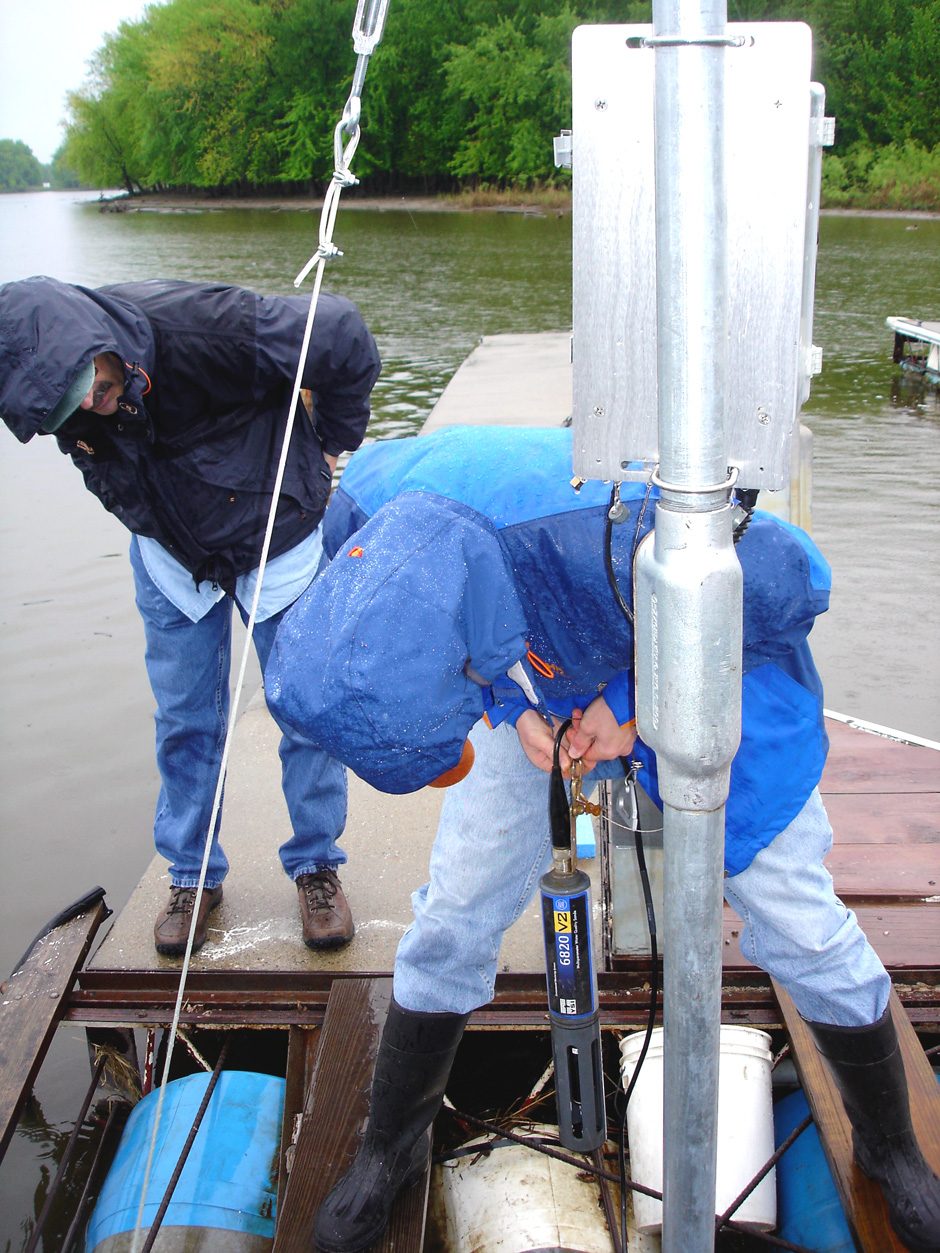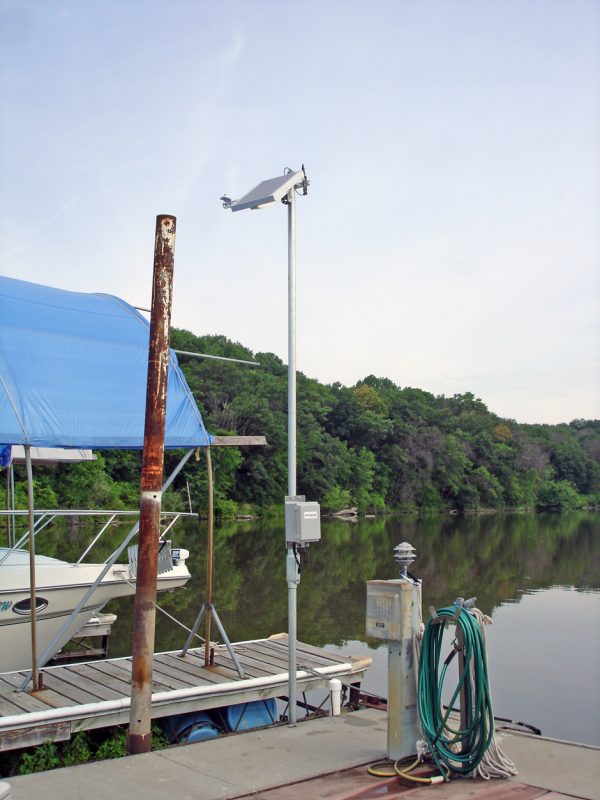From Tallgrass Prairie to Garlic Mustard: Katharine Ordway Natural History Study Area at Macalester College Reveals Environmental Monitoring Surprises
 Installation of the YSI 6820 data sonde by Dan Hornbach (Professor of Environmental Studies) and Jerald Dosch (Director of Ordway). (Photo Credit: Ken Moffett, Scientific Instrumentation Technician)
Installation of the YSI 6820 data sonde by Dan Hornbach (Professor of Environmental Studies) and Jerald Dosch (Director of Ordway). (Photo Credit: Ken Moffett, Scientific Instrumentation Technician)Katharine Ordway enjoyed the tallgrass prairies of Minnesota throughout her life, and when she inherited a substantial fortune, she decided to spend a significant part of it to preserve them. Today, the Katharine Ordway Natural History Study Area is part of her conservation legacy. The mission of Ordway includes four pillars: education, research, sustainability and civic engagement. Ordway is a living laboratory for students ranging from elementary to college age, available for class field trips, school visits, and community outings. It is also a place where independent researchers, faculty members, undergraduate and graduate students from Macalester and other colleges and universities can do research. Photographers, painters and other artists are also free to use Ordway in pursuit of their creative passions.
Michael Anderson, Associate Director at Katharine Ordway Natural History Study Area (also known as Ordway Field Station) and Biology Instructor at Macalester College, has been Associate Director and Resident Naturalist at Ordway for 15 years. He also lives at the Field Station. He works closely with colleagues from Macalester including Dan Hornbach, (an aquatic ecologist), Mark Davis (a terrestrial ecologist) and Jerald Dosch (an ornithologist and Director of Ordway). “Many different types of environmental monitoring are done here,” says Anderson. “It’s a 287-acre area, of which 120 is backwater lake habitat that sits at the end of the Mississippi River channel. About 20 acres is tallgrass prairie with a wetland in the middle.”
Ordway has land management projects which have involved some of the wetlands and the oak woodland along the Macalester shoreline of the Mississippi River. Ordway also has an ongoing burn program to maintain the prairie habitat and research on invasive plant species. A variety of management efforts have taken place over the years in order to maintain habitat and species diversity at the site.
“One of the unique projects we have had here, in terms of terrestrial monitoring, is our garlic mustard research project,” says Anderson. Garlic mustard has been researched at Ordway since 2010. Vegetation transects are monitored and topographic data is also collected. Slope aspect elevation data is gathered and light is measured. “Garlic mustard is one of the first plants to show up in the spring, and it’s often one of the last plants still green in the fall,” says Anderson. “It is a surprising plant. It doesn’t behave like a typical, competitive invasive plant is thought to act. It moves from location to location and follows holes in the canopy that are letting light through. It’s not outcompeting the native species. The native species simply don’t take advantage of those holes like the garlic mustard does. The garlic mustard is also self-limiting. We may have some in an area for several years, and then it will disappear by itself.” Other native plant species being monitored at Ordway include pointed-leaf tick trefoil, hog peanut, Enchanter’s nightshade, white snakeroot, gooseberries, raspberries and Virginia creeper.
Other terrestrial monitoring projects include measuring the growth of invasive species such as buckthorn, honeysuckle and reed canary grass.

Pictured here is the NexSens iSIC data logger for the water quality station. It contains a cell phone modem for communication and a solar panel for power. (Photo Credit: Ken Moffett, Scientific Instrumentation Technician)
Terrestrial monitoring also includes tree monitoring, and Ordway is part of the Ecological Research as Education Network (EREN) permanent forest plot project. The Ordway plot has 600 marked and tagged trees in 12-20 x 20 plots which have been monitored since 2011. The DBH for each tree is recorded using field tape measures. Compasses and clinometers are used to obtain the data. Some of the major tree species at Ordway include pin oak, red oak, burr oak, basswood, white oak and slippery elm. “We have been losing a significant number of trees,” says Anderson. “They get taken out by storms.”
There is also a lot of animal monitoring done at Ordway. Work has been done to look at predation rates of ovenbirds inside Ordway compared to those nesting outside the grounds. “We have had higher rates of ovenbird predation inside Ordway, and that seems related to raccoons, who come here from surrounding residential habitats,” says Anderson. “They are comfortable living in the residential areas, then come over to Ordway and help themselves to ovenbird nests as well. Raccoons are known to be intelligent, but the intelligence they’ve displayed during our efforts to track and learn about them has still surprised us. They’ve proven to be very hard to tag and track, more so than other species we’ve worked with.”
Ordway also monitors map and snapping turtles.
About four to six Macalester undergraduates assist with vegetation surveys and tree measurements, as well as ovenbird and turtle population counts.
Trail cameras are used to monitor raccoon activity, as well as deer populations for about 90 miles along the Mississippi National Park corridor. Bald eagles and otters are also surveyed with trail cameras by the National Park Service.
Ordway also participated in the 2011 Minnesota BioBlitz, sponsored by the University of Minnesota Bell Museum. In the BioBlitz, a site is chosen, and for 24 hours, volunteers from a variety of scientific disciplines, including mycologists, entomologists and ichthyologists, collect all the living things they can find, identifying and curating them.
“We have a weather station and water monitoring station here at Ordway,” mentions Anderson. “All data for both the weather station and water monitoring station at Ordway is available online.” Dan Hornbach, Aquatic Ecologist, notes that there are special pieces of equipment used in long-term monitoring at both the weather and water stations. “Both the weather and water stations use NexSens iSIC data loggers. The weather station uses a WXT520 multiparameter weather sensor and LiCor PAR sensor. The water quality station uses a YSI model 6820 data sonde, YSI Model 6150 DO ROX sensor, YSI Model 6136 Turbidity Probe, wiped, a YSI Model 6561 pH probe, and an OTT Level Logger.” In terms of short term monitoring, oxygen, temperature and water level are measured in a couple of ponds and PAR, wind speed, air temperature and relative humidity are monitored to assess ecosystem metabolism. “We used HOBO sensors from Onset,” Hornbach adds.
Katharine Ordway would no doubt be pleased with all the environmental monitoring, conservation, and land management being done at her namesake field station at Macalester today.




0 comments